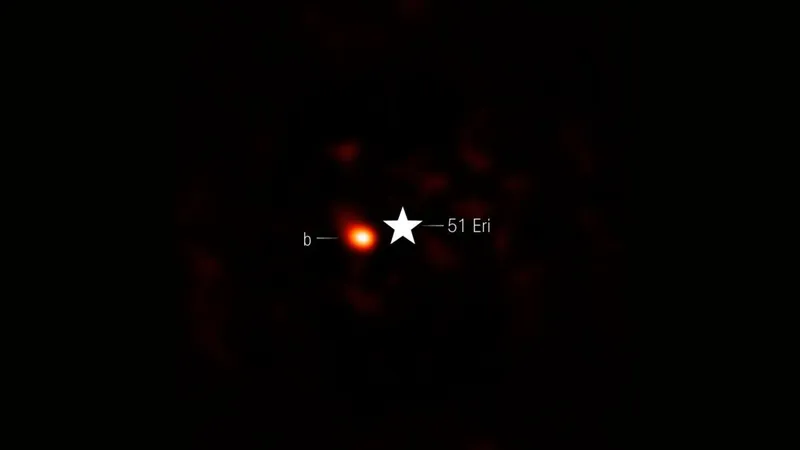
Scientists Break New Ground in Exoplanet Imaging with JWST Innovations!
2025-04-01
Author: Ming
Revolutionary Imaging Techniques in Exoplanet Research
In an impressive achievement, astronomers recently revealed groundbreaking images of exoplanets in the HR 8799 and 51 Eridani star systems, using an unconventional approach with the powerful James Webb Space Telescope (JWST). This new method not only enhances our understanding of these distant worlds but also revitalizes the ongoing quest to find extraterrestrial life.
Significance of Direct Imaging
William Balmer, a Ph.D. candidate at Johns Hopkins University and the lead author of the research, elaborated on the significance of direct imaging for studying exoplanets. He stated, "Direct imaging reveals crucial details about the atmosphere's structure and composition, allowing us insights unaffected by the light of the star it orbits."
Challenges of Capturing Clear Exoplanet Images
One of the major hurdles in capturing clear images of distant exoplanets is the overwhelming brightness of their host stars. The JWST, equipped with its advanced technology, including a large mirror and specialized instruments, excels in detecting faint light emissions in the mid-infrared spectrum—pushing the boundaries of what is possible in exoplanet research.
Innovative Use of Coronagraphs
Balmer and his team creatively employed the JWST’s coronagraphs in a non-traditional way. Normally designed to block starlight, they adjusted the coronagraph masks to allow more light to leak around the edges—essentially "using the coronagraphs wrong." This innovative approach enabled them to isolate the light from the planets, unveiling details previously obscured by the star’s brightness.
Critical Stability of JWST
"The stability of the JWST was critical. We used comparison images of similar stars without known planets to effectively subtract the star's light, allowing us to detect the fainter signals from the planets more clearly," Balmer explained.
First Images at 4.6 Micron Wavelength
The study marked a historic milestone with the first-ever images of HR 8799 at the 4.6-micron wavelength, where ground-based observations have long been impeded by atmospheric interference. Balmer emphasized the unique capabilities of the JWST, located a million miles away from Earth's atmosphere, which makes such observations feasible.
Insights into Planetary Composition
In addition to capturing images at previously impossible wavelengths, the team identified significant carbon dioxide levels in the atmospheres of the HR 8799 planets. This information is vital for understanding the origins of these planets: high carbon dioxide concentrations often indicate an abundance of heavy elements, suggesting these planets formed through a process called core accretion, where rocky cores accumulate thick gaseous atmospheres.
Diversity in Chemical Compositions
The findings also revealed an unexpected diversity in the chemical compositions and "colors" of the inner planets in the HR 8799 system. Unlike previous observations that suggested similarity, the mid-infrared imaging suggested that varying atmospheric conditions, such as vertical mixing of gases, play a crucial role in distinguishing these planets.
Surprising Atmospheric Chemistry in 51 Eridani b
The excitement doesn't stop there! The JWST also detected unexpected carbon chemistry in 51 Eridani b, suggesting a more metal-rich environment than previously thought. This observation hints that the planet's atmosphere is heavily influenced by the confluence of lower atmospheric gases, reshaping our understanding of atmospheric dynamics on exoplanets.
Future Research Directions
Looking towards the future, Balmer and his colleagues are eager to conduct further research. They have been granted 23 additional hours with the JWST to investigate four more planetary systems, aiming to refine models for atmospheric interactions and better understand the formation processes of gas giants.
Conclusion and Implications for Extraterrestrial Life
These innovative imaging techniques and findings not only shine a light on the complexities of exoplanet atmospheres but also pave the way for future explorations in our search for life beyond Earth. Stay tuned as scientists continue to make groundbreaking discoveries that could change our understanding of the universe!




 Brasil (PT)
Brasil (PT)
 Canada (EN)
Canada (EN)
 Chile (ES)
Chile (ES)
 Česko (CS)
Česko (CS)
 대한민국 (KO)
대한민국 (KO)
 España (ES)
España (ES)
 France (FR)
France (FR)
 Hong Kong (EN)
Hong Kong (EN)
 Italia (IT)
Italia (IT)
 日本 (JA)
日本 (JA)
 Magyarország (HU)
Magyarország (HU)
 Norge (NO)
Norge (NO)
 Polska (PL)
Polska (PL)
 Schweiz (DE)
Schweiz (DE)
 Singapore (EN)
Singapore (EN)
 Sverige (SV)
Sverige (SV)
 Suomi (FI)
Suomi (FI)
 Türkiye (TR)
Türkiye (TR)
 الإمارات العربية المتحدة (AR)
الإمارات العربية المتحدة (AR)